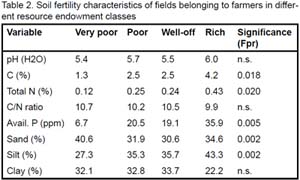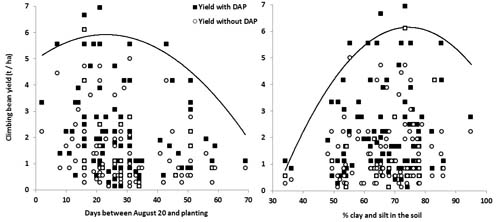Climbing bean is a key crop in the northern Rwandan cropping system, grown by 95% of the interviewed households in the N2Africa baseline survey. N2Africa promotes the use of improved varieties and P based fertilizers in climbing bean cultivation in Rwanda. Through dissemination trials, farmers get the opportunity to test new climbing bean technologies. N2Africa monitors in each country a sample of these multi-locations trials through a field book providing valuable information on driver of variability in yield and in performance of N2Africa technologies.
In this study, we monitored 115 dissemination trials with climbing bean in northern Rwanda, in which farmers compared climbing bean grown with organic inputs only with bean grown with both organic inputs and DAP (di-ammonium phosphate) fertilizer. We collected agronomic data, soil data, as well as information on the socio-economic background of the N2Africa farmer. In the analyses, we made use of a household typology based on resource endowment (Table 1). In Rwanda, a unique situation exists where rural households have been categorised according to a governmental typology called ‘Ubudehe’ (translated: local collective action). From Table 1, it can be seen that the majority of the N2Africa households belong to (very) poor households that have an arable farm size of less than 0.5 ha.
The average climbing bean grain yields in the dissemination trials equalled 1.40 t ha-1 in the control plot and 2.06 t ha-1 in the plots with DAP fertiliser. The addition of DAP to climbing bean in the dissemination trials gave a grain yield increase of more than 10% at 81% of the sites (Fpr < 0.001). Climbing bean grain yields varied widely between sites (Fig. 1), which is typical for on-farm, farmer-managed trials reflecting a wide variety in biophysical and management conditions.

 |
Fig. 1. Response of climbing bean fresh grain yield to the application of P fertiliser, segregated by (A) households classes and (B) gender of the farmer. The line represents the one-to-one line where the yield in the control plot (manure only) equals that in the plot with DAP fertiliser |
| Timing of crop management operations (planting, weeding) significantly affected productivity. The boundary analyses in Fig 2A indicate that maximum attainable yield rapidly declines if climbing bean is planted after the end of September. None of the individual soil parameters was significantly linearly correlated with grain yield in the two bean treatments. However, the yield enhancing effect of DAP fertiliser application indicated that P and possibly N limit climbing bean productivity in the vast majority of fields. Moreover, the scatter graph of percentage clay and silt and climbing bean yield (Fig. 2B) indicates that maximum attainable yield is less when the percentage clay and silt in the soil is below 50%. From concurrent detailed farm characterisations in the area, we know that staking density and organic input use are two other important variables correlated with climbing bean productivity. |
 |
 |
Fig. 2. Relationship between climbing bean grain yield and (A) days between August 20 and planting and (B) the percentage silt and clay in the soil. The lines in the graph indicate maximum obtainable yield at a given planting date or percentage clay and silt in the soil, derived through boundary analyses |
Analyses of soil samples from the dissemination trials showed significant relationships between household class and soil fertility characteristics (Table 2). Poorer households have soils poorer in fertility as indicated by a lower C, N, available P and higher sand contents. Resource endowment was positively related to climbing bean productivity in the dissemination trials (Fig. 1A). Poorly resource endowed farmers were thus not only disadvantaged in term of farm size, but also in their production capacity per unit area. Moreover, the gender of the farmer implementing the trial was significantly related to grain yield of beans and maize (Fig. 1B). Female farmers achieved smaller average yields than their male counterparts. Female farmers did not belong more frequently to resource-poor households than male farmers and therefore, household resource endowment did not explain the difference in performance between male and female farmers. Resource endowment and gender can be seen as a proxy for a range of other factors that determine crop productivity, such as soil fertility, access to organic manure and mineral fertiliser, access to sufficient quality staking material, ability to conduct crop management operations on time, etc.
Conclusions
A large inequity in resource endowment among rural households in Rwanda is reflected by differences in soil fertility, crop management and productivity, and most likely also in abilities to adopt new technologies. The poorest households can easily be by-passed in rural development programs such as N2Africa unless attention is paid to their particular challenges.
Similarly, particular attention should be paid to the needs of women farmers who attained substantially smaller yields per unit area than men due to unequal access to resources within the household.
The very small landholdings among the poor rural households observed in this study highlight a binding constraint to making any major steps forward in increasing crop productivity and food self-sufficiency for these households. While increases in crop productivity per unit area are important to relieve drudgery, off-farm income will be indispensable for these households to escape from poverty.
While the regional average yield increase as a result of the use of DAP fertiliser is strong and highly significant, the variability in yields is very large. Understanding what causes this large variability in yield is key to improving the effectiveness of N2Africa’s dissemination activities
Linus Franke, Freddy Baijukya, Speciose Kantengwa, Moritz Reckling, Bernard Vanlauwe, Ken Giller
